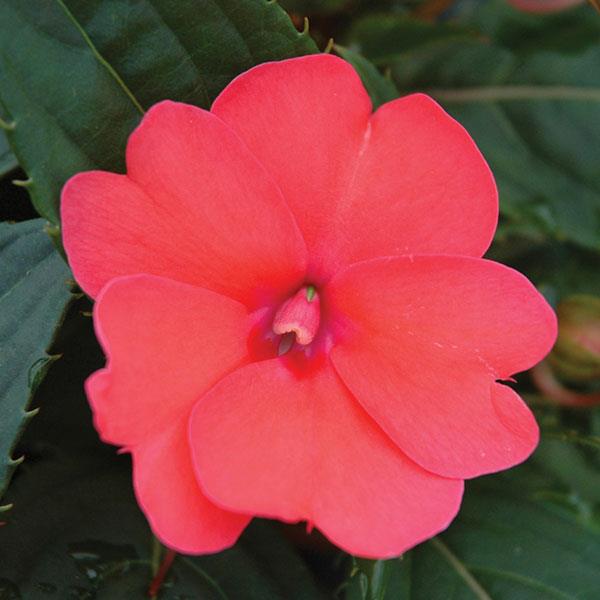Impatiens, Sunpatien Compact Deep Rose
$8.99
Plant, Zone 9+
Discount per quantity
| Quantity | 3 - 8 | 9 - 14 | 15+ |
|---|---|---|---|
| Price | $8.72 | $8.45 | $8.09 |
| % Discount | 3% | 6% | 10% |
Description
SunPatiens® Compact Deep Rose: A Bright Heartbeat for Every Garden
Welcome! We’re about to dive into a flower that lifts spirits the moment you see it. SunPatiens Compact Deep Rose brings quick color, easy care, and lasting joy. Whether you garden on a patio, a balcony, or a big backyard, this variety stays tidy, blooms nonstop, and helps you feel connected to the living world around you. Let’s explore what makes it special and then walk step by step through its simple care routine.
1. Meet SunPatiens Compact Deep Rose
1.1 A Color That Sings
Deep Rose is not shy. Each petal glows with warm pink tones that lean toward magenta. The color holds steady from the first bloom in spring until the final cool nights of fall. Even on cloudy days, the flowers seem to shine from within.
1.2 Built for the Sun and the Shade
SunPatiens are a cross between traditional shade impatiens and hearty New Guinea impatiens. That clever breeding gives them power to bloom in many light levels. Compact Deep Rose loves morning sun, afternoon shade, or bright dappled light under trees. If you give it at least four hours of sun, you’ll see its fullest show.
1.3 Tidy by Nature
The “Compact” line reaches only about 14–20 inches tall and wide. It keeps a neat mound shape on its own, so you spend less time pinching and more time enjoying.
1.4 Fast Start, Long Finish
SunPatiens leap ahead in growth as soon as the soil warms. Flowers appear early, fill in gaps quickly, and stay fresh through heat waves and short droughts. The plant keeps its leaves glossy and green, acting like its own backdrop for the blooms.
1.5 A Versatile Player
Place it in beds, hanging baskets, window boxes, or modern mixed planters. It pairs well with bold foliage like coleus or sweet potato vine. It also bridges the color gap between cooler spring tones and fiery fall shades, making it an all-season hero.
2. Why Choose the Compact Series?
- Space-saving form. Perfect for smaller gardens or patio containers.
- Controlled vigor. You get high flower power without wild overgrowth.
- Wind resistance. Shorter stems sway but rarely snap.
- Uniform look. Every plant in a flat grows to about the same size, so design plans stay balanced.
- Less maintenance. No deadheading needed; spent blooms drop away on their own.
3. Design Ideas and Companion Pairings
3.1 Cottage Charm Border
Set a front ribbon of Compact Deep Rose, then layer airy blue salvia behind it. Edge the back with creamy white gaura. The palette feels fresh and welcoming.
3.2 Tropical Patio Pot
Combine Deep Rose with chartreuse sweet potato vine and upright caladium. Add a draping asparagus fern for texture. Place it near a seating area so you and your guests can appreciate the color mix up close.
3.3 Shady Walkway Glow
Line a path that gets filtered morning light. Alternate Deep Rose with white begonias. The pink pops while white keeps the scene calm.
3.4 Pollinator Pocket
Even though impatiens aren’t top nectar plants, the vivid petals still draw the curious eye of butterflies. Mix in lavender, lantana, or dwarf zinnias to boost the buffet. Together, they invite more winged visitors to your garden.
4. How to Care for SunPatiens Compact Deep Rose
We’re moving into practical steps now. As we go, remember that SunPatiens were bred to forgive mistakes. Follow these basics and you’ll succeed.
4.1 Light
| Setting | Hours of Direct Sun | Result |
|---|---|---|
| Full Sun | 6–8 | Maximum bloom count, tighter habit |
| Partial Sun | 4–6 | Reliable bloom, richer foliage |
| Bright Shade | 2–4 | Fewer but larger flowers, lush leaves |
Aim for at least four hours, especially morning sun, for best color.
4.2 Soil
SunPatiens like loose, well-drained soil rich in organic matter. If your ground is heavy clay, mix in compost and finely shredded bark. Container mixes should be peat- or coco-fiber-based with perlite added.
pH sweet spot: 5.8 – 6.5 (slightly acidic).
4.3 Watering
- Frequency in beds: About 1 inch of water per week, delivered in one or two deep soakings.
- Frequency in pots: Check daily in peak heat. Water when the top inch feels dry.
- Method: Water at soil level. Keep foliage dry to cut disease risk.
SunPatiens wilt slightly to tell you they’re thirsty, then perk back up fast once watered.
4.4 Feeding
| Season Stage | Fertilizer Type | Rate |
|---|---|---|
| Planting Day | Slow-release 14-14-14 granules | 1 tablespoon per gallon of pot size, or light sprinkle in bed |
| Mid-Summer | Water-soluble 20-10-20 | Every 10–14 days in containers; every 3 weeks in beds |
| Late Season | Stop feeding 4 weeks before first frost | — |
A balanced nutrient blend keeps leaves deep green and supports nonstop buds.
4.5 Temperature and Humidity
- Ideal daytime: 70–90 °F.
- Night minimum: 55 °F.
- Humidity: Moderate to high is fine. Dry air may lead to spider mites, so mist nearby foliage if the season is very arid.
4.6 Pruning and Grooming
You rarely need to pinch Compact Deep Rose. If stems stretch in lower light, trim by one-third. Remove brown leaves at the base to improve airflow. Spent flowers self-shed, saving you time.
4.7 Overwintering (Optional)
SunPatiens are grown as annuals in most zones. If you live in Zone 10 or warmer, they might survive outdoors year-round. In cooler zones, take 4-inch cuttings in late summer. Root them in water or seed-starting mix indoors. Give them bright light and gentle bottom heat. Plant them out again in spring.
4.8 Common Challenges and Solutions
| Issue | Sign | Fix |
|---|---|---|
| Root rot | Plants collapse even when soil seems wet | Improve drainage; water only when top layer dries |
| Spider mites | Speckled leaves, fine webbing | Hose off undersides, apply insecticidal soap weekly until clear |
| Downy mildew (rare in SunPatiens) | Pale patches under leaves | Increase spacing, water early in day, remove sick plants |
Because SunPatiens were bred with disease resistance in mind, serious problems are few and far between.
4.9 Propagation
- Cuttings: Clip 3–4-inch tips early morning. Strip lower leaves. Dip in rooting hormone (optional). Insert into moist, sterile mix. Cover with a ventilated dome. Roots form in 7–10 days at 72 °F.
- Seeds: Not offered for SunPatiens. Stick with cuttings if you want clones.
5. Season-Long Care Calendar
| Month | Task |
|---|---|
| April | Harden off nursery plants; plant after the last frost. Mulch lightly. |
| May–June | Feed with slow-release granules. Water deeply after heat spikes. |
| July | Trim lightly if busy stems crowd each other. Add soluble feed. |
| August | Watch for mites; rinse leaves weekly. Dead foliage removal. |
| September | Reduce feeding. Take cuttings if you plan to overwinter indoors. |
| October | Bring potted backups inside, or enjoy the blooms until first frost. |
Following this simple rhythm keeps care stress-free.
6. Creative Container Recipe: “Sunset Smoothie”
One 14-inch patio bowl.
- Center: 1 SunPatiens Compact Deep Rose (thriller).
- Edge spill: 3 trailing golden lysimachia.
- Filler: 2 coleus ‘Kong Lime Sprite’.
- Accent: A tuft of purple fountain grass at the back for height.
The rose, gold, lime, and purple echo a sunset’s layers. Place it by the entryway to welcome guests with instant cheer.
7. Fun Activities for Families
- Petal Press Art: SunPatiens petals hold color when pressed between parchment and heavy books. Kids can turn them into bookmarks.
- Color Math: Use the pink petals to practice counting or sorting with younger children. “How many blooms do we see today?”
- Time-Lapse Challenge: Set up a phone camera and record a bloom opening over a day. Share the clip with friends.
These small projects connect people of all ages to plant life cycles.
8. Sustainable Moves
We care about the planet, too. Here’s how SunPatiens help:
- Fewer chemical sprays. High disease resistance means less fungicide use.
- Lower water bills. Once roots establish, they need less water than many bedding plants.
- Pollinator support. Add them to mixed pollinator patches so butterflies find color cues that guide them to higher-nectar flowers nearby.
9. Frequently Asked Questions
- Can I grow SunPatiens in full shade?
They will survive, but flowering slows. Aim for at least partial sun for best results. - Do deer eat them?
SunPatiens are not deer favorites. In heavy pressure zones, still use a repellent. - Will they self-seed?
No. Seeds, if formed, won’t breed true. Enjoy them anew each season. - How often should I repot?
In large containers, once per season is enough. Choose fresh mix each spring. - What’s the lifespan indoors?
With bright light and pruning, a rooted cutting may bloom indoors for 6–8 months, though flower count is lower than outdoors.
10. Your Next Step
Now you’re ready. Pick up a tray of SunPatiens Compact Deep Rose, tuck them into your favorite spots, and watch your outdoor living space come alive with color. Share the blooms with neighbors, snap photos for memories, and feel the simple joy that only vibrant flowers can give.
Petals of Promise Ahead
Together, we’ve uncovered how SunPatiens Compact Deep Rose brings big beauty with little effort. Plant it, care for it the easy way, and let every rosy flower remind us that gardening doesn’t have to be hard—it just has to be heartfelt.
Additional information
| Weight | N/A |
|---|---|
| Options | Starter Plug – 3 count, 4 in. (16.9 fl. oz.) Pot |





